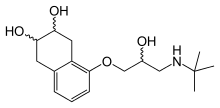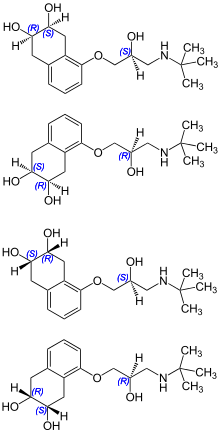Nadolol
 | |
| Clinical data | |
|---|---|
| Trade names | Corgard |
| AHFS/Drugs.com | Monograph |
| MedlinePlus | a682666 |
| Pregnancy category |
|
| Routes of administration | Oral |
| ATC code | |
| Legal status | |
| Legal status | |
| Pharmacokinetic data | |
| Protein binding | 30% |
| Metabolism | Not metabolised |
| Elimination half-life | 14-24 hours |
| Excretion | Renal and fecal (unchanged) |
| Identifiers | |
| |
| CAS Number | |
| PubChem CID | |
| IUPHAR/BPS | |
| DrugBank | |
| ChemSpider | |
| UNII | |
| KEGG | |
| ChEMBL | |
| ECHA InfoCard |
100.050.625 |
| Chemical and physical data | |
| Formula | C17H27NO4 |
| Molar mass | 309.401 g/mol |
| 3D model (JSmol) | |
| |
| |
| (verify) | |
Nadolol (Corgard) is a non-selective beta blocker used in the treatment of high blood pressure and chest pain. Additionally, it is often prescribed in the treatment of atrial fibrillation, migraine headaches, and complications of cirrhosis.
Chemistry
Nadolol is a mixture of stereoisomers. It is polar and hydrophilic, with low lipid solubility.[1]

Medical uses
Nadolol is used to treat hypertension and for long-term treatment of angina pectoris and is approved by the FDA for these purposes.[2]
It is regularly used off-label[2] for control of heart rate in people with atrial fibrillation,[3] prevention of migraine headaches;[4] prevention of bleeding veins in people with portal hypertension caused by cirrhosis;[5] and to treat people with high levels of thyroid hormone.[6]
Nadolol is one of the preferred beta-blockers in the management of patients with LQTS for shortening of the QT interval and prevention of ventricular arrhythmia. It is more efficacious than cardioselective beta-blockers like metoprolol and propanolol in the prevention of breakthrough cardiac events[7]. Nadolol has the advantage of once daily dosing and thus improved patient compliance. For patients with decreased kidney function, nadolol may be dosed less often.[8] It has also been found to be useful (off-label) for several neurological disorders such as the prevention of migraine attacks,[9] attention deficit/hyperactivity disorder(ADHD)[10] and its use has been explored as a treatment for essential tremor[11] and Parkinson's disease[12] but neither is well established.[13][14][15]
Mechanism of action
Nadolol is a non-selective beta blocker; that is, it non-selectively blocks both beta-1 and beta-2 receptors. It has a preference for beta-1 receptors, which are predominantly located in the heart, thereby inhibiting the effects of catecholamines and causing a decrease in heart rate and blood pressure. Its inhibition of beta-2 receptors, which are mainly located in the bronchial smooth muscle of the airways, leads to airway constriction similar to that seen in asthma. Inhibition of beta-1 receptors in the juxtaglomerular apparatus of the kidney inhibits the renin–angiotensin system, causing a decrease in vasoconstriction and a decrease in water retention. Nadolol's inhibition of beta-1 receptors in the heart and kidney leads to its effects on lowering blood pressure.
The drug impairs AV node conduction and decreases sinus rate.
Nadolol may also increase plasma triglycerides and decrease HDL-cholesterol levels.
Side effects
The most common side effects include dizziness and fatigue.[12]
Contraindications
Nadolol and other beta blockers should be used with cautions in people with heart failure and its use should not be abruptly stopped. It is contraindicated for people with asthma, a slow heart rate and certain severe heart problems.[16]
See also
References
- ↑ Bragg W, Norton D, Shamsi SA (November 2008). "Optimized separation of beta-blockers with multiple chiral centers using capillary electrochromatography-mass spectrometry". J Chromatogr B. 875 (1): 304–16. doi:10.1016/j.jchromb.2008.06.028. PMC 2680439. PMID 18619928.
- 1 2 Nadolol entry in AccessMedicine. McGraw-Hill Global Education Holdings, LLC. Accessed 8 November 2014
- ↑ January CT, Wann LS, Alpert JS, Calkins H, Cigarroa JE, et al. "2014 AHA/ACC/HRS guideline for the management of patients with atrial fibrillation: a report of the American College of Cardiology/American Heart Association Task Force on practice guidelines and the Heart Rhythm Society". Circulation. 130: e199–267. doi:10.1161/CIR.0000000000000041. PMC 4676081. PMID 24682347.
- ↑ Silberstein SD, Holland S, Freitag F, Dodick DW, Argoff C, et al. (2012). "Evidence-based guideline update: pharmacologic treatment for episodic migraine prevention in adults: report of the Quality Standards Subcommittee of the American Academy of Neurology and the American Headache Society". Neurology. 78 (17): 1337–45. doi:10.1212/WNL.0b013e3182535d20. PMC 3335452. PMID 22529202.
- ↑ Giannelli V, Lattanzi B, Thalheimer U, Merli M. "Beta-blockers in liver cirrhosis". Ann Gastroenterol. 27 (1): 20–26. PMC 3959530. PMID 24714633.
- ↑ Bahn RS, Burch HB, Cooper DS, Garber JR, Greenlee MC, et al. (2011). "Hyperthyroidism and Other Causes of Thyrotoxicosis: Management Guidelines of the American Thyroid Association and American Association of Clinical Endocrinologists". Thyroid. 21 (6): 593–646. doi:10.1089/thy.2010.0417. PMID 21510801.
- ↑ Mazzanti A, Maragna R, Vacanti G, Monteforte N, Bloise R, et al. (15 April 2018). "Interplay Between Genetic Substrate, QTc Duration, and Arrhythmia Risk in Patients With Long QT Syndrome". Journal of the American College of Cardiology. 71 (15): 1663–1671. doi:10.1016/j.jacc.2018.01.078.
- ↑ "Corgard (nadolol) dosing, indications, interactions, adverse effects, and more". reference.medscape.com. Retrieved 27 May 2017.
- ↑ "Nadolol - a beta-blocker - Corgard. High blood pressure drugs". patient.info. Retrieved 27 May 2017.
- ↑ Barkley, Russell A.; Murphy, Kevin R. (27 May 2017). "Attention-deficit Hyperactivity Disorder: A Clinical Workbook". Guilford Press. Retrieved 27 May 2017 – via Google Books.
- ↑ Zesiewicz TA, Elble RJ, Louis ED, Gronseth GS, Ondo WG, et al. (Nov 2011). "Evidence-based guideline update: treatment of essential tremor: report of the Quality Standards subcommittee of the American Academy of Neurology". Neurology. 77 (19): 1752–5. doi:10.1212/WNL.0b013e318236f0fd. PMC 3208950. PMID 22013182.
- 1 2 U.S. National Library of Medicine Nadolol entry in Medline Plus
- ↑ Foster NL, Newman RP, Lewitt PA, Gillespie MM, Larsen TA, et al. (October 1984). "Peripheral beta-adrenergic blockade treatment of parkinsonian tremor". Ann Neurol. 16: 505–508. doi:10.1002/ana.410160412.
- ↑ "Nadolol: MedlinePlus Drug Information". www.nlm.nih.gov. Retrieved 27 May 2017.
- ↑ "Nadolol Dosage Guide with Precautions - Drugs.com". drugs.com. Retrieved 27 May 2017.
- ↑ "Corgard Label" (PDF). fda.gov. Retrieved 27 May 2017.